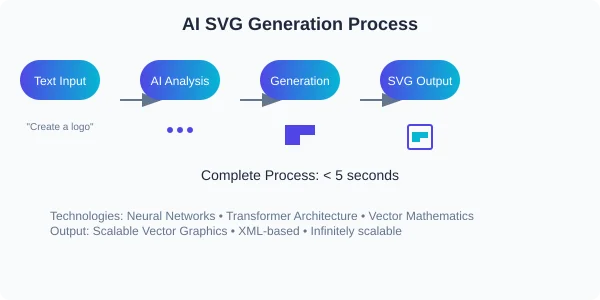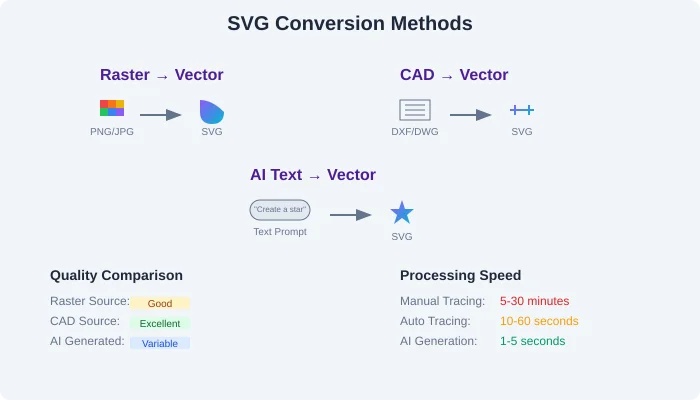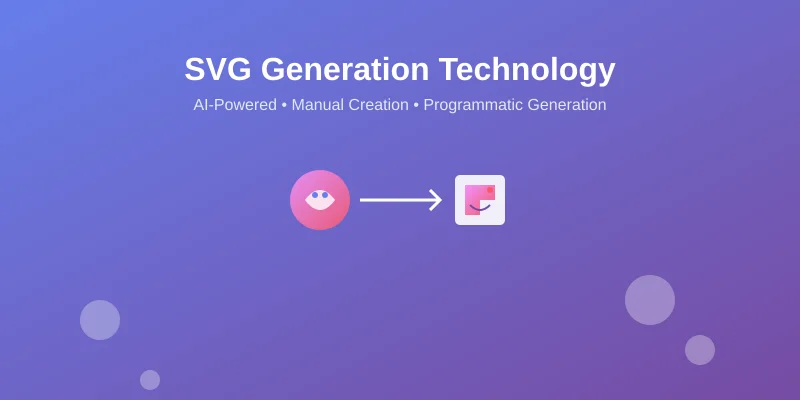Introduction
For designers seeking efficient workflows, our AI-powered SVG Creator tools generate professional icons, logos, and illustrations from text descriptions—produce custom designs instantly with clean optimized paths and infinite scalability. Scalable Vector Graphics (SVG) have revolutionized digital design, offering infinite scalability without quality loss. As web standards evolve and design requirements become more sophisticated, the technology behind SVG generation has advanced dramatically. Whether you're looking to SVG generator solutions or exploring advanced AI-powered creation tools, understanding the landscape of SVG generation technology is crucial for modern digital creators. This comprehensive guide explores every aspect of SVG generation, from traditional manual methods to cutting-edge artificial intelligence approaches. We'll examine the tools, techniques, and technologies that enable designers and developers to generate SVGs instantly for any application.What is SVG Generation Technology?
SVG generation technology encompasses all methods, tools, and systems used to create Scalable Vector Graphics. Unlike raster images that use pixels, SVGs use mathematical descriptions of shapes, paths, and objects, making them infinitely scalable and perfect for responsive web design.Core Components of SVG Technology
Vector Mathematics: At its foundation, SVG generation relies on vector mathematics to define shapes, curves, and paths using mathematical formulas rather than pixel grids. This includes Bézier curves, parametric equations, and geometric transformations that maintain precision at any scale. XML Structure: SVGs are built on XML markup, making them both human-readable and machine-parseable. This structure enables programmatic generation, manipulation, and integration with web technologies like CSS and JavaScript. Web Standards Compliance: Modern SVG generation tools adhere to W3C SVG specifications, ensuring cross-browser compatibility and future-proofing. The SVG 2.0 specification introduces enhanced features like mesh gradients and improved text handling. Coordinate Systems: SVG uses a flexible coordinate system with viewBox attributes that enable responsive scaling and precise positioning across different display contexts. Path Data Optimization: Advanced SVG generation employs path optimization algorithms to minimize file size while maintaining visual fidelity through techniques like curve simplification and redundant point removal.Types of SVG Generation Methods
For rapid design iteration, our AI-driven SVG Maker generates multiple design variations from text prompts in seconds—create matching icons, logos, and graphics instantly with consistent styling across all your projects.1. AI-Powered SVG Generation
Artificial intelligence has transformed how we approach vector graphics creation. Modern AI systems can generate scalable vector graphics from simple text prompts, analyzing patterns from millions of existing designs to create original artwork. Machine Learning Approaches:- Generative Adversarial Networks (GANs): Research from NVIDIA shows how GANs can generate high-quality vector graphics through adversarial training between generator and discriminator networks
- Transformer Models: OpenAI's CLIP technology enables text-to-vector generation using attention mechanisms that understand semantic relationships between text and visual elements
- Diffusion Models: Stable Diffusion adaptations for vector output, utilizing denoising processes to gradually refine vector representations
- Variational Autoencoders (VAEs): Encode vector graphics into latent spaces for manipulation and generation
- Neural Style Transfer: Apply artistic styles to vector graphics while preserving structural integrity
2. Manual SVG Creation Tools
Traditional design software remains essential for precise, custom SVG creation. These tools offer granular control over every aspect of the vector graphic. Professional Design Software:- Adobe Illustrator: Industry standard for vector graphics
- Inkscape: Open-source alternative with full SVG support
- CorelDRAW: Professional vector graphics suite
- Sketch: Mac-focused design tool with excellent SVG export
- Vectr: Free online vector graphics editor
- Boxy SVG: Dedicated SVG editor
- Method Draw: Simple online SVG editor
3. Programmatic SVG Generation
For developers and automated workflows, programmatic SVG generation offers unlimited flexibility and scalability. JavaScript Libraries:- D3.js: Data-driven document manipulation for SVG
- SVG.js: Lightweight library for SVG manipulation
- Snap.svg: Modern SVG library for animation and interaction
- Paper.js: Vector graphics scripting framework
- Matplotlib: Scientific plotting with SVG output
- Pygal: Python SVG charting library
- svgwrite: Programmatic SVG creation
- Go SVG: Go library for SVG generation
- SVG.NET: .NET library for SVG handling
- Cairo: Cross-platform 2D graphics with SVG support
4. Conversion-Based SVG Generation
Many SVG workflows begin with converting existing graphics from other formats. Raster to Vector Conversion:- Adobe Illustrator's Image Trace
- Inkscape's Trace Bitmap
- Vector Magic: Online bitmap to vector conversion
- Potrace: Open-source bitmap tracing
AI-Powered SVG Generation: The Future is Here
Artificial intelligence has emerged as the most exciting frontier in SVG generation technology. Modern AI systems can understand natural language descriptions and transform them into sophisticated vector graphics.How AI SVG Generation Works
Neural Network Architecture: Modern AI systems, including our cutting-edge SVG generator platform, use transformer architectures similar to those powering ChatGPT, but trained specifically on vector graphics data. These models employ multi-head attention mechanisms to understand spatial relationships and hierarchical structures in vector graphics. Training Data: AI models are trained on millions of SVG files, learning patterns in:- Shape relationships and proportions across different design contexts
- Color harmony and design principles from established art theory
- Typography and layout conventions from professional design systems
- Industry-specific design patterns for logos, icons, and illustrations
- Geometric constraints and mathematical relationships in vector paths
- Cultural and contextual design elements for global applications
- Text Analysis: Natural language processing interprets user prompts using semantic understanding and context analysis
- Concept Mapping: AI maps abstract concepts to concrete visual elements through learned associations
- Compositional Planning: Algorithms determine optimal layout, hierarchy, and spatial relationships
- Vector Generation: Mathematical formulas create scalable paths using spline curves and geometric primitives
- Style Application: Design principles ensure aesthetic coherence through color theory and visual balance
- Optimization: Post-processing reduces file size and improves rendering performance
- Quality Validation: Automated checks ensure output meets technical and aesthetic standards

Advantages of AI SVG Generation
Speed and Efficiency: What once took hours can now be accomplished in seconds. Professional designers can generate SVGs instantly for rapid prototyping and iteration. Accessibility: Non-designers can create professional-quality graphics without extensive training or expensive software. Consistency: AI ensures brand consistency across large projects by following established style guidelines. Infinite Variations: AI can generate multiple variations of a concept, enabling A/B testing and design exploration.Current Limitations and Future Potential
While AI SVG generation is powerful, current limitations include:- Precision Control: Fine-tuning specific elements still requires manual intervention for exact specifications
- Complex Compositions: Multi-layered designs with intricate hierarchies may need human oversight and refinement
- Brand Specificity: Custom brand elements often require manual training or style transfer techniques
- Contextual Understanding: AI may struggle with highly specific cultural or technical contexts
- Mathematical Accuracy: Technical diagrams requiring precise measurements need validation
- Copyright and Originality: Ensuring generated content doesn't inadvertently copy existing designs
Manual SVG Creation: Traditional Methods
Despite AI advances, manual SVG creation remains crucial for projects requiring precise control, unique artistic vision, or specific technical requirements.Professional Design Software Capabilities
Adobe Illustrator: The industry standard offers:- Bezier curve tools for precise path creation
- Advanced typography with SVG font support
- Gradient meshes and complex fills
- Seamless integration with other Adobe products
- Full W3C SVG standard compliance
- Native SVG format (no conversion needed)
- Extensive plugin ecosystem
- Cross-platform compatibility
- Component-based design systems
- Collaborative workflows
- Responsive design features
- Developer handoff with clean SVG export
Best Practices for Manual SVG Creation
Optimize Path Complexity: Minimize anchor points while maintaining shape fidelity. Adobe's optimization guidelines recommend using the fewest points necessary. Consider File Size: Manual optimization can significantly reduce file sizes:- Remove unnecessary metadata
- Simplify complex paths
- Use symbols for repeated elements
- Optimize color palettes
- Use relative units when possible
- Test at multiple sizes during creation
- Ensure text remains readable at all scales
Programmatic SVG Generation for Developers
For technical applications, programmatic SVG generation offers unparalleled control and automation capabilities.Data Visualization
D3.js Ecosystem: D3.js has revolutionized data visualization, enabling:- Real-time data binding to SVG elements
- Complex animations and transitions
- Interactive visualizations
- Custom chart types and infographics
Automated Design Systems
Component Generation: Modern design systems use programmatic SVG generation for:- Icon libraries with consistent styling
- Automated logo variations
- Responsive graphic elements
- Brand compliance automation
- React SVG components: Convert SVGs to React components
- Vue SVG Loader: Vue.js integration
- Angular SVG: Native SVG support
Server-Side Generation
Node.js Solutions: Server-side SVG generation enables:- Dynamic chart generation for reports
- Automated social media graphics
- Print-ready document creation
- Real-time infographic updates
Converting to SVG: Transformation Technologies
SVG generation often involves converting existing graphics from other formats, requiring sophisticated transformation algorithms.
Raster to Vector Conversion
Tracing Algorithms: Modern tracing uses advanced algorithms:- Potrace algorithm: Mathematical approach to edge detection using polygon fitting and curve optimization
- Machine learning enhancement: Adobe's Sensei improves tracing accuracy through neural network-based edge detection
- Multi-pass processing: Handles complex images with multiple detail levels using hierarchical decomposition
- Autotrace: Alternative open-source vectorization engine
- Deep learning approaches: Research from Carnegie Mellon shows neural networks can achieve superior vectorization results
- Live tracing: Real-time conversion capabilities for interactive design workflows
- Source image resolution and clarity (minimum 300 DPI recommended for optimal results)
- Color complexity and gradients (fewer colors produce cleaner vector output)
- Edge definition and contrast (high contrast images trace more accurately)
- Intended use case and scaling requirements (technical vs. artistic applications)
- Noise levels and compression artifacts in source images
- Image preprocessing techniques (blur reduction, contrast enhancement, noise removal)
CAD File Conversion
Technical Drawing Standards: Converting technical drawings requires understanding:- ISO technical drawing standards
- CAD software specifications
- Precision requirements for manufacturing
- Layer management and organization
- AutoCAD built-in SVG export
- SolidWorks technical illustration tools
- FreeCAD open-source conversion
Font to SVG Conversion
Typography Applications: Converting fonts to SVG paths enables:- Custom web typography without font loading
- Logo creation with precise text control
- Print applications requiring outline fonts
- Icon font alternatives
Industry Applications and Use Cases
AI-powered tools let designers create SVG graphics through streamlined workflows—generate custom icons, logos, and illustrations that meet professional standards across diverse industries and use cases. SVG generation technology serves diverse industries with specific requirements and workflows.Web Development
Responsive Design: SVGs excel in responsive web design:- Crisp display at any screen density
- Smaller file sizes than equivalent raster images
- CSS styling and animation capabilities
- Accessibility benefits with text-based markup
Marketing and Advertising
Brand Consistency: SVG technology ensures brand elements maintain quality across:- Digital advertising platforms
- Print materials at any size
- Promotional merchandise
- International market adaptations
- Personalized marketing graphics
- Real-time campaign adjustments
- A/B testing with visual variations
- Cross-platform consistency
Technical Documentation
Engineering Applications: Technical industries rely on SVG for:- Assembly instructions and manuals
- Patent illustrations and diagrams
- Scientific journal figures
- Educational materials and textbooks
- IEEE documentation standards
- Industry-specific requirements
- Accessibility guidelines (WCAG 2.1)
- International printing standards
Gaming and Entertainment
Asset Pipeline: Game development uses SVG for:- UI elements and interfaces
- 2D game assets and sprites
- Marketing materials and promotional graphics
- Documentation and style guides
- Mobile devices with varying screen densities
- Console gaming on large displays
- VR/AR applications requiring infinite scaling
- Cross-platform game deployment
Technical Considerations and Best Practices
Successful SVG generation requires understanding technical limitations and optimization strategies.Performance Optimization
File Size Management: Effective optimization techniques include:- SVGO optimization: Automated cleanup and compression
- Path simplification: Reducing unnecessary anchor points
- Attribute optimization: Removing default values and metadata
- Compression: Gzip compression can reduce SVG files by 60-80%
- Complex paths can slow rendering on older devices
- CSS animations perform better than SMIL animations
- Multiple small SVGs may outperform single large files
- Critical rendering path optimization
Browser Compatibility
Modern Standards Support: Current browsers support:- SVG 1.1 specification (universal support)
- SVG 2.0 features (partial support)
- CSS integration and styling
- JavaScript interaction and manipulation
- Fallback strategies using raster alternatives
- Polyfills for missing features
- Progressive enhancement approaches
- Can I Use SVG data for feature support
Accessibility Standards
WCAG Compliance: SVG accessibility requires:- Meaningful
<title>and<desc>elements - Proper contrast ratios for text elements
- Alternative text for complex graphics
- Keyboard navigation support
Security Considerations
SVG Security Risks: Be aware of potential vulnerabilities:- JavaScript execution in SVG files through embedded
<script>tags - XML external entity (XXE) attacks exploiting DTD processing
- Cross-site scripting (XSS) through SVG uploads containing malicious code
- OWASP security guidelines for web application security
- Remote file inclusion through external references
- Denial of service attacks using recursive or computationally expensive SVG elements
- Content Security Policy (CSP) headers restricting script execution
- SVG sanitization libraries like DOMPurify before display
- Server-side validation and cleanup using whitelist approaches
- Restricted execution environments and sandboxing
- Input validation for file uploads and user-generated content
- Regular security audits and penetration testing
Future of SVG Generation Technology
The SVG generation landscape continues evolving with emerging technologies and changing user needs.Advanced AI Integration
Next-Generation Models: Future AI developments include:- Multimodal AI: Systems understanding both text and visual inputs for more accurate interpretation
- Style Transfer: Applying artistic styles to vector graphics while preserving structural integrity
- Real-time Generation: Instant SVG creation during design workflows with sub-second response times
- Context Awareness: AI understanding project requirements, brand guidelines, and industry constraints
- Collaborative AI: Systems that work alongside human designers as creative partners
- Adaptive Learning: Models that improve based on user feedback and design outcomes
- Cross-Domain Transfer: AI trained on diverse visual domains for broader creative capabilities
- Improved geometric understanding
- Better text-to-image alignment
- Enhanced artistic control
- Reduced computational requirements
WebAssembly and Performance
WASM Integration: WebAssembly enables:- High-performance SVG generation in browsers
- Desktop-quality tools running on the web
- Cross-platform consistency
- Reduced server-side processing needs
- Real-time vector rendering
- Complex animation processing
- Large dataset visualization
- Interactive graphic manipulation
Augmented and Virtual Reality
Immersive Design: SVG technology adapts for:- AR Applications: Overlaying vector graphics on real-world scenes
- VR Environments: Infinite scalability crucial for immersive experiences
- Mixed Reality: Combining real and virtual vector elements
- Spatial Computing: Vector graphics in 3D space
- 3D vector representation
- Spatial interaction models
- Cross-platform compatibility
- Performance optimization
Collaborative Design Platforms
Real-Time Collaboration: Future platforms will feature:- Simultaneous multi-user editing
- AI-assisted design suggestions
- Version control for vector graphics
- Cloud-based processing and storage
- Design tools and development environments
- Marketing platforms and creation tools
- Project management and creative workflows
- Analytics and design optimization
Choosing the Right SVG Generation Method
Selecting appropriate SVG generation technology depends on specific project requirements, technical constraints, and resource availability.Decision Framework
Project Scope Assessment:- Volume Requirements: How many graphics need generation?
- Complexity Level: Simple icons or complex illustrations?
- Timeline Constraints: Immediate needs or longer development cycles?
- Quality Standards: Professional marketing or internal documentation?
- Platform Compatibility: Web-only or cross-platform needs?
- Integration Needs: Standalone tools or workflow integration?
- Customization Level: Standard outputs or extensive modification?
- Performance Constraints: Real-time generation or batch processing?
- Team Skills: Design expertise vs. technical implementation?
- Budget Constraints: Free tools or enterprise solutions?
- Time Investment: Learning curves vs. immediate productivity?
- Maintenance Requirements: One-time creation or ongoing updates?
